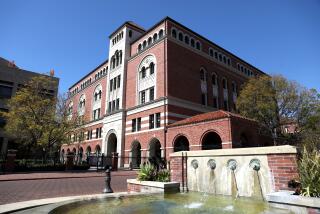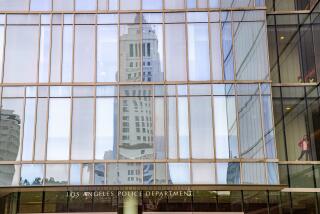High Court Weighs Survivors’ Privacy
- Share via
WASHINGTON — A Los Angeles lawyer’s solitary probe into the “mysterious death” nearly 10 years ago of former White House deputy counsel Vincent Foster has forced the U.S. Supreme Court to confront a recurring dispute in the aftermath of a tragedy.
What is the proper line between the public’s right to know and the right to privacy of the families who lost a loved one?
Lawyer Allan J. Favish says the public cannot know the truth about the Foster case unless it has all the facts. “It was clear to me there was an intent to deceive” by the government, Favish said. That’s why he says he needs to have authorities release to him 10 close-up, color photos of Foster’s body.
On Friday, the Supreme Court reviewed a series of appeals, all triggered by Favish’s efforts to further explore the circumstances of Foster’s death.
Foster’s widow and his sister have moved to block the release of the photos. They called Favish a conspiracy theorist whose pursuit of the pictures is ghoulish. U.S. Solicitor General Theodore B. Olson also moved to block Favish, saying there is no public interest in a sixth investigation of Foster’s death.
Since the assassination of President Kennedy, the government has faced claims that its failure to release certain photos or other information is is evidence of an official cover-up. Similar questions have arisen more recently in connection with the Sept. 11 attacks.
However, judges have been divided on when the privacy right outweighs the value in public disclosure.
On July 20, 1993, Foster left the White House after having lunch at his desk. His body was found later that day at Ft. Marcy Park in Virginia, which overlooks the Potomac River.
He was a longtime friend of President Clinton and a law partner of Hillary Rodham Clinton’s in Little Rock, Ark.
Foster had run into rough treatment in Washington during the first six months of the new administration. In mid-June, the Wall Street Journal’s editorial page had turned a harsh light on him. “Who is Vincent Foster?” demanded the headline on one editorial denouncing the Clintons and their aides.
“I was not meant for the job or the spotlight of public life in Washington,” Foster wrote in a note found in his briefcase after his death. “Here ruining people is considered sport.”
U.S. Park Police and the FBI investigated his death, as did separate House and Senate committees. Independent counsels Robert B. Fiske Jr. and Kenneth W. Starr also investigated. All of them concluded that Foster had committed suicide.
But in the parallel world of the Internet, theories abounded over who killed Vince Foster.
“Most people think it was a murder made to look like a suicide. If I had to bet, I’d say it was murder,” said Favish, 47, who says he is acting on his own, although he once represented Accuracy in Media, a conservative group that tried and failed to obtain photos of Foster. He said he first became interested in Foster after reading about his case on the Internet.
In 1997, Favish filed a Freedom of Information Act request for 150 photos taken at Ft. Marcy. When the government turned him away, he filed a lawsuit in Los Angeles.
U.S. District Judge William D. Keller agreed Favish could have 140 of the photos. They show Foster’s car and the gun that was found in his hand.
Favish has posted them on his own Web site, along with a commentary entitled “Fostering a Lie.”
But the judge refused to order the release of the close-up photos of Foster’s body. The Freedom of Information Act has an exception for law enforcement records that would cause “an unwarranted invasion of privacy.”
Favish appealed. He contended there was no privacy issue.
“Privacy is a personal right. Your right to privacy dies when you die,” Favish said. “These are photos of Vince. Lisa can’t assert a privacy interest.”
He was referring to Foster’s widow, Lisa Foster Moody. She and her sister-in-law, Sheila Foster Anthony, filed a brief saying it “would be extremely upsetting to their family,” including Foster’s children, if these photos were released.
“My mother has suffered unimaginable sorrow in losing her only son,” Anthony said in her declaration. “Her grief [and ours] has been compounded by the fear ... she will see [these] photographs in the tabloids on the grocery store racks.”
Favish says he does not find this argument legally persuasive. “I don’t see any privacy interest. I can see a widow, standing in a supermarket line, would be emotionally upset if she saw these [photos] in a tabloid. But that’s not a legal privacy interest.”
While a U.S. 9th Circuit Court of Appeals panel agreed Foster’s family had a privacy interest in the photos, two of three judges said they were not convinced that all of the close-up photos were “graphic, explicit and extremely upsetting.”
Judges John Noonan and Diarmuid O’Scannlain told Judge Keller in Los Angeles to reexamine the photos himself and release those that were not upsetting.
Judge Harry Pregerson dissented. “I am persuaded that the public’s interest ... is more than adequately served” by the more than 100 photos already released, he said. And the public value of a further disclosure of close-up photos of the body “does not outweigh the privacy interests of Vincent Foster’s surviving family,” he said.
After a second round of litigation, four of 10 photos of Foster’s body were set for release to Allan Favish.
But the Supreme Court will have the final word.
Olson has appealed to challenge the forced release of the photos of the body.
“Favish wants a sixth guess, not a second guess,” he said. “When five investigations in different branches of the federal government have uniformly reached the same result, the contribution to public understanding by a sixth investigation by an unsatisfied private citizen can make is marginal at best,” Olson said in one of the appeals, Office of Independent Counsel vs. Favish.
Attorney James Hamilton appealed on behalf of Foster’s widow and sister, urging the high court to block the release on privacy grounds.
The family “experienced acute distress” when a photograph leaked in 1994 showing Foster’s dead hand holding a gun. It will be extremely upsetting to them if the close-up photos are released to the public, he said in the case, Sheila Foster Anthony vs. Favish.
The privacy issue is not a new one. The government refused to release autopsy photos of President Kennedy. It also blocked the release of audio recordings of the last words of the crew of the space shuttle Challenger.
Lawyers say they also expect a new round of litigation over the last words of those who died on Sept. 11 at the World Trade Center and on Flight 93. Hamilton cites these examples and argues the Supreme Court should rule clearly on the privacy rights of survivors.
For his part, Favish also has appealed to the Supreme Court seeking all 10 photographs, not just four set for release now.
“I included a detailed discussion of the blood flow,” he said in describing his appeal. If Foster shot himself as the government asserts, blood should be splattered everywhere, he said. “If there is a just a trickle out of his mouth, and it’s not a horrible wound, that would be weird and not consistent,” he said.
The photos “may help solve the mystery about the blood flow patterns,” he wrote in his appeal in Favish vs. Office of Independent Counsel. The Supreme Court justices, who met Friday to consider appeals, may announce as early as Monday what they will do with the three appeals in the Foster case.
More to Read
Sign up for Essential California
The most important California stories and recommendations in your inbox every morning.
You may occasionally receive promotional content from the Los Angeles Times.














